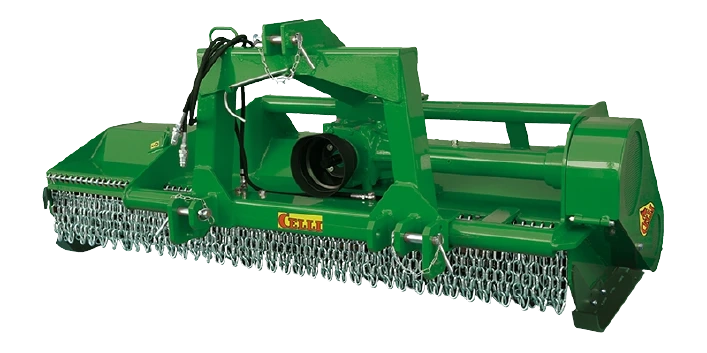A flail mower, by definition, replaces blades with banks of flails (or "knives"). A flail is a small piece of metal that works by pounding (flailing) the grass and breaking it off. The task is completed quickly and efficiently. A Rotary mower is something that most of us are familiar with. Rotary mowers may cut in any direction, including forwarding, backward, and sideways. This is because the blades of a rotary mower spin parallel to the ground. As the blade spins, it chops off the grass or material's base, causing it to fall to the ground. If the material or grass is tall, it may be chopped again as it falls. The material being sliced is normally immediately below the cutting blade.
The blades of a flail mower spin vertically to the ground, and when they contact the grass or material to be cut, the grass or material is raised and sliced/chopped several more times before being expelled out the back of the flail mower. Instead of dropping out of the way, the material you're cutting is hung beneath the mowing deck. The density/volume of material that a flail mower can feed and cut is critical. The task's speed must be matched. This leads us to the fundamentals of flail mower operation.
Mow Forward
You can only mow in one direction: forward. If you need to back up, elevate the mower deck as you do so. Lower your flail mower and continue mowing in a forward direction when you're ready to go ahead again. Mowing backwards wraps the shaft and burns the belts out.
The Tractor should have enough power
Always run your Flail mower at the tractor's engine speed, which is 540 RPM for the PTO. The speed of the flail mower blade tip is critical for preserving the flail mower's capacity to lift the material it is cutting. When the tractor PTO speed is too low, the mower will bog down and the power belts will slip and burn.
Use low gears at the start
Always begin mowing projects in the lowest gear possible. Increase the tractor's forward speed till the material exiting the flail mower's back isn't completely cut. Then take it easy for a while. You've calculated the maximum pace at which you can do this task using your tractor, material, and flail mower. The power belts will slide and burn if you mow at a pace that is too rapid for the mower to mow effectively.
A flail mower prevents bunching by not throwing anything to the left or right. Our machines have rotors that rotate in the opposite direction. Cut material is picked up and discarded virtually where it was cut, right behind the forward-moving machine. Because struck items have a restricted trajectory, you can mow in places with a lot of rubbish and spectators.
Expert tips to know about flail mowers
Even at minimal forward tractor speed, the Top centre hitch link can be utilised to modify cutting height if the material is too high or thick to cut in one pass. When mowing normally, the top link should be adjusted so that the mower rests with the front edge slightly raised. When necessary, the top hitch link may be extended to elevate the mower's front edge even higher. As a result, the material will feed into the mower over a broader region, and the material will be chopped at a higher level. After that, return the flail mower deck to its original position and cut your project a second time at the specified height.
0
0


